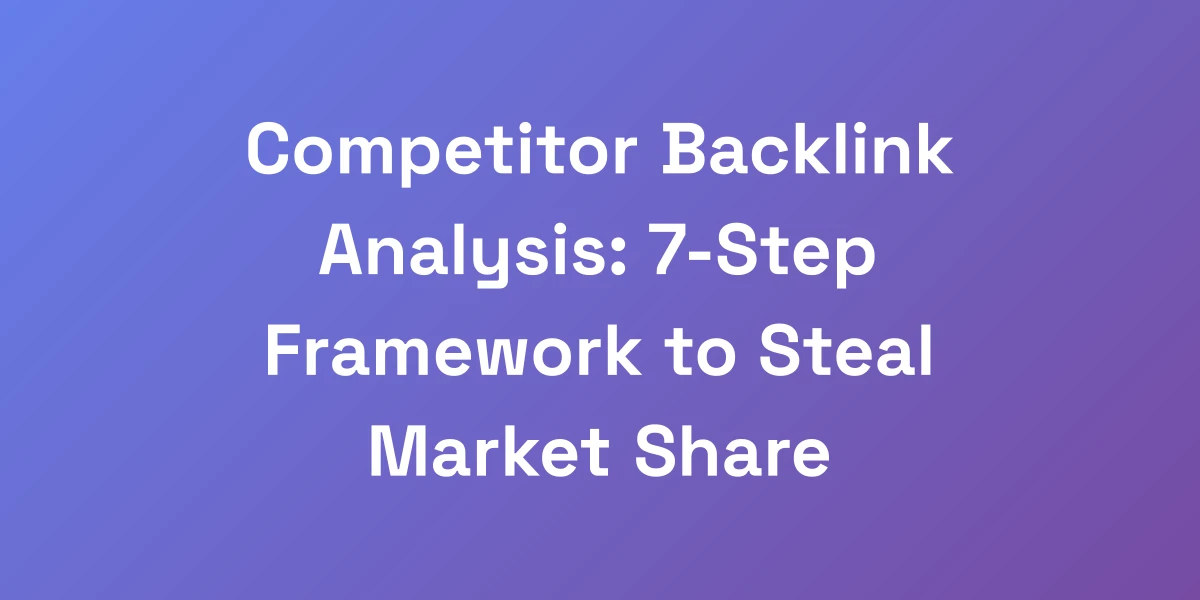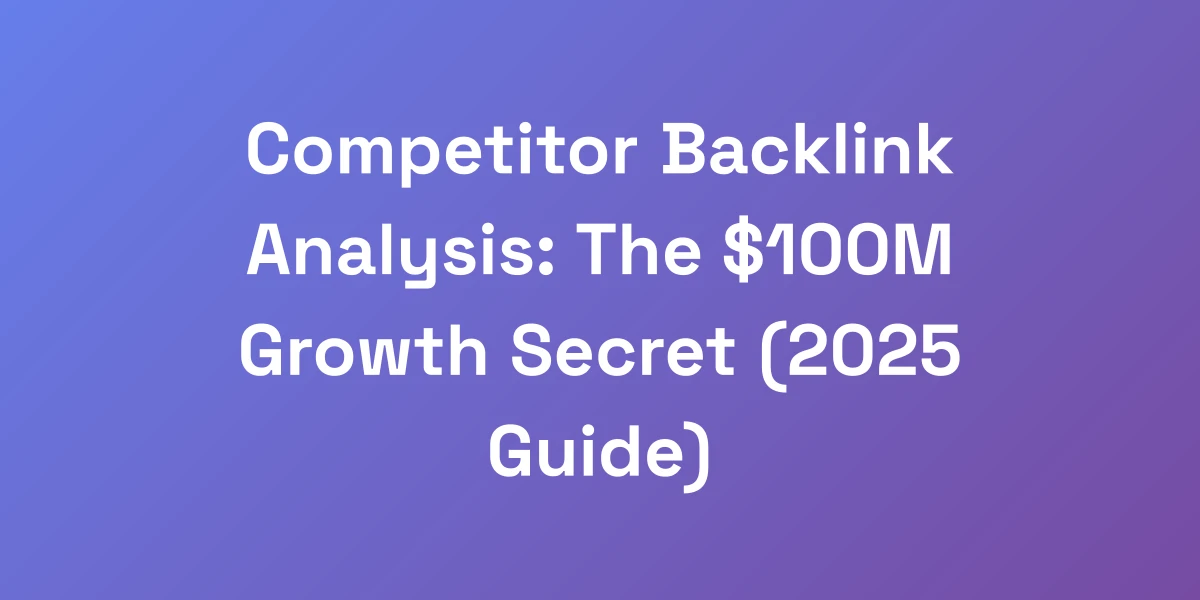
Competitor Backlink Analysis: 7-Step Framework to Steal Market Share
Mar 15, 2025 | By [email protected]
Understanding the Gold Mine: Why Competitor Backlink Analysis is Your Secret Weapon
Let us cut to the chase. Most businesses are spinning their wheels, creating content and hoping for backlinks. It’s akin to throwing darts blindfolded—more likely to miss than hit the mark.
But what if we told you there’s a smarter way? A method to reverse engineer your competitors’ success by dissecting their competitor backlink analysis strategies. This isn’t about shamelessly copying links; it’s about understanding the entire ecosystem propelling your competitors forward and systematically dismantling their advantage.
The challenges are real. Navigating the complexities of backlink analysis can be daunting, but with the right framework, you can turn these challenges into opportunities. The framework we’re sharing has empowered our clients to generate millions in additional revenue by targeting the backlinks that genuinely move the needle.
The Real ROI of Competitor Backlink Analysis
Backlink analysis isn’t just another SEO task; it’s a revenue generator. According to Ahrefs SEO statistics, there’s a strong correlation (0.68) between the number of backlinks and search engine rankings. High-ranking pages boast nearly 4x more backlinks than their lower-ranked counterparts.
But it’s not just about quantity. Quality backlinks from authoritative sources can significantly enhance your site’s credibility and visibility, driving organic traffic that converts. For instance, Victorious highlighted that analyzing competitors’ backlinks can uncover fresh tactics and new link opportunities, directly impacting your bottom line.
Common Misconceptions About Backlink Strategy
Many believe that any backlink is beneficial. This misconception leads to poor link-building practices, such as acquiring links from low-quality or irrelevant sites. Research from Authority Hacker shows that 93.8% of link builders prioritize quality over quantity, emphasizing that the relevance and authority of links matter more than sheer numbers.
Another myth is that backlinks alone can guarantee top rankings. In reality, backlinks are just one part of a broader SEO strategy. Combining quality backlinks with outstanding content and user experience is essential for sustained success.
Why Most Businesses Fail at Link Building
Failing is easy when your approach lacks strategy. Many businesses fall into the trap of chasing every backlink opportunity without a clear plan. This scattergun approach can dilute efforts and waste resources.
Furthermore, without understanding the competitive landscape, it’s challenging to identify which backlinks will provide the most significant impact. As Fire Us Marketing notes, top-ranking pages have nearly 4x more backlinks than lower-ranked pages, but not all of these backlinks are created equal. Focusing on strategic link acquisition is crucial for meaningful results.
For small businesses, implementing affordable SEO strategies for small businesses can help prioritize high-impact backlinks without breaking the bank.
The Compound Effect of Strategic Link Acquisition
Strategic link acquisition leverages the compound effect—small, consistent gains that accumulate into substantial growth over time. By targeting high-impact backlinks, businesses can see exponential improvements in their search rankings and organic traffic.
Consider link building case studies, like The Mattress Nerd case study, where a focused link-building strategy led to a 243% increase in organic traffic within six months. This illustrates how methodical link acquisition can create a ripple effect, enhancing overall SEO performance and driving sustained business growth.
The 7-Step Competitor Backlink Analysis Framework
After analyzing thousands of websites and investing millions in SEO, we’ve distilled competitor backlink analysis into a proven 7-step framework. This isn’t theoretical fluff—it’s a battle-tested system delivering consistent results. The key lies in focusing on high-impact activities that offer the most significant returns on your time investment.
Here’s how to identify, prioritize, and acquire the backlinks that will propel your business forward, not just inflate vanity metrics.
Step 1: Identifying Your True Competitors
Not all competitors are created equal. Start by identifying who truly competes with you in the digital landscape. These are not just businesses offering similar products or services but those ranking for your target keywords.
- Direct Competitors: Businesses offering the same products or services as you.
- Indirect Competitors: Companies in your industry that offer different products or services but compete for the same audience.
- Content Competitors: Sites that produce content targeting the same keywords and audience as you.
Use tools like Ahrefs or SEMrush to analyze who ranks for your primary keywords. This will give you a clear picture of whom you need to monitor and learn from.
Step 2: Creating Your Competitor Backlink Database
Once you’ve identified your competitors, the next step is to compile a comprehensive backlink database. This involves collecting all the backlinks pointing to your competitors’ websites.
- Data Collection: Utilize tools like Ahrefs, Majestic, and SEMrush, as well as the best backlink APIs in 2024 to gather backlink data.
- Data Organization: Categorize backlinks by source, type, and authority.
- Continuous Monitoring: Keep your database updated to track new backlinks competitors acquire.
Maintaining an updated database allows you to spot trends, identify new opportunities, and stay ahead of your competitors’ link-building efforts.
Step 3: Quality Assessment Framework
Not all backlinks are created equal. Assess the quality of each backlink based on several key metrics to ensure they will benefit your SEO strategy.
- Domain Authority (DA):strong> Higher DA indicates a more authoritative site.
- Relevance: Links from sites related to your industry are more valuable.
- Link Type: Editorial links are more valuable than paid or reciprocal links.
For example, Majestic SEO provides unique metrics like Trust Flow and Citation Flow, which help in evaluating the quality and trustworthiness of a backlink source.
Step 4: Opportunity Gap Analysis
This step involves identifying the gaps between your backlink profile and that of your competitors. Determine which high-quality backlinks your competitors have that you lack.
- Identify Missing Links: Look for authoritative sites linking to your competitors but not to you.
- Evaluate Link Opportunities: Assess the potential value of these missing links.
- Strategize Acquisition: Develop a plan to acquire these valuable backlinks.
By targeting these gaps, you can focus your efforts on acquiring links that will have the most significant impact on your SEO performance.
Step 5: Link Pattern Recognition
Understanding the pattern recognition in machine learning can reveal effective link-building strategies by analyzing the patterns in your competitors’ backlink profiles.
- Content Analysis: Identify the types of content that attract the most backlinks.
- Outreach Strategies: Analyze how your competitors are reaching out for backlinks.
- Anchor Text Distribution: Examine the anchor texts used in their backlinks to understand keyword targeting.
For instance, FatJoe emphasizes that recognizing these patterns allows you to adjust your SEO strategy to target similar domains and improve your backlink profile.
Step 6: Acquisition Strategy Development
With a clear understanding of the opportunities and patterns, develop a strategy to acquire the desired backlinks.
- Content Creation: Develop high-quality, link-worthy content that attracts backlinks naturally.
- Outreach Campaigns: Use personalized outreach templates to connect with potential backlink sources.
- Partnerships: Build long-term content partnerships with industry leaders to secure authoritative backlinks.
Utilize tools like Serpstat and SE Ranking to streamline your outreach efforts and ensure your campaigns are efficient and effective.
Step 7: Implementation and Tracking
Putting your strategy into action requires meticulous implementation and ongoing tracking.
- Execute Outreach: Send out your personalized outreach emails and follow up diligently.
- Track Progress: Use custom tracking systems to monitor the success of your backlink acquisition efforts.
- Adjust Strategies: Continuously refine your approach based on what’s working and what’s not.
Implementing a robust tracking system ensures you can measure the effectiveness of your strategies and make data-driven decisions to optimize your efforts further. Additionally, integrating automated SEO reporting can streamline this process by providing real-time insights.
Advanced Tools and Automation for Scale
Let’s face it: manual backlink analysis is a time-consuming endeavor that drains resources. Here’s the kicker—manual processes kill ROI. We’ve developed systems that automate 80% of the grunt work, enabling you to zero in on high-leverage activities.
The right tools aren’t just about saving time—they’re about uncovering insights your competitors overlook. Here’s how you can build a tech stack that scales your backlink analysis without ballooning your team or budget.
Essential Tools for Professional Analysis
- Ahrefs: Offers detailed backlink analysis, competitor research, and site audits. Renowned for its comprehensive backlink data.
- SEMrush: Provides robust backlink audits, competitor link tracking, and automated outreach features, praised for its holistic SEO approach.
- Moz Link Explorer: Features link analysis, spam score monitoring, and domain authority metrics, valued for its reliable metrics.
- BuzzSumo: Ideal for content-driven backlink strategies with content discovery and link tracking features.
- Monitor Backlinks: Specializes in backlink analysis, offering a focused approach to understanding and improving link profiles.
- AI Tools for SEO: Utilize artificial intelligence to enhance backlink analysis accuracy and efficiency.
Automation Workflows That Save Hours
Automation is key to scaling your backlink analysis efforts efficiently. Tools like Ahrefs and SEMrush offer automation features that handle repetitive tasks, freeing up your time for strategic planning.
- Automated Data Collection: best backlink APIs in 2024 can be set up to regularly gather backlink data from competitors.
- Scheduled Audits: Automate site audits to continuously monitor the health and quality of your backlink profile.
- Outreach Automation: Use templates and automated follow-ups to streamline your outreach campaigns.
Implementing these workflows can drastically reduce the time spent on manual tasks, allowing you to focus on high-impact strategies. Additionally, investing in automatic SEO optimization tools can further enhance your ability to streamline and optimize your backlink efforts.
Custom Tracking Systems
Tracking the performance of your backlink strategies is essential for measuring success. Custom tracking systems can help you monitor key metrics and gain actionable insights.
- Dashboard Integration: Integrate your backlink data into a centralized dashboard for real-time monitoring.
- Custom Alerts: Set up alerts for significant changes in your backlink profile, such as new high-authority links or lost backlinks.
- Performance Metrics: Track metrics like Domain Authority, Trust Flow, and organic traffic to evaluate the impact of your backlinks.
Data Visualization Techniques
Data visualization transforms raw data into intuitive insights. Use charts, graphs, and heatmaps to make sense of your backlink data and identify trends.
- Trend Analysis: Visualize backlink growth over time to identify patterns and measure progress.
- Competitor Comparison: Create side-by-side visual comparisons of your backlink profiles against competitors.
- Opportunity Mapping: Use heatmaps to identify the most lucrative backlink opportunities.
Effective visualization techniques help in quickly identifying what’s working and what needs adjustment, enhancing your decision-making process.
ROI Measurement Tools
Measuring the return on investment (ROI) of your backlink strategies ensures you’re investing your resources wisely. Utilize tools that link your SEO efforts to tangible business outcomes.
- Google Analytics: Track the impact of backlinks on organic traffic, user behavior, and conversions.
- SEMrush ROI Tool: Analyze the financial return of your link-building campaigns by correlating backlinks with revenue growth.
- Custom ROI Dashboards: Develop dashboards that track specific KPIs related to your backlink strategies, providing a clear view of ROI.
These tools help you quantify the impact of your efforts, ensuring that your backlink strategies are driving real business value.
Implementing Your Findings: From Analysis to Action
Data is only as good as the actions you take. Many businesses get stuck in analysis paralysis, gathering data but never translating it into actionable plans. We’re here to change that. Let us guide you in transforming your competitor backlink analysis into a systematic action plan.
Forget about creating endless spreadsheets. Instead, we’ll help you build a repeatable process that generates consistent results. Focus on the 20% of actions that deliver 80% of the results, ensuring every hour you spend on backlink building drives real business outcomes.
Creating Your Priority Action List
- Identify High-Value Links: Focus on acquiring backlinks from high-authority and relevant sites identified in your analysis.
- Set Clear Objectives: Define what you aim to achieve with each backlink acquisition, such as increased traffic or higher domain authority.
- Prioritize Opportunities: Rank backlink opportunities based on their potential impact and ease of acquisition.
Outreach Templates That Convert
Effective outreach is crucial for successful link acquisition. Crafting compelling, personalized outreach templates can significantly improve your conversion rates.
- Personalization: Tailor your messages to the recipient, referencing their work or interests to establish a connection.
- Relevance: Ensure your proposal aligns with the recipient’s niche or current content to increase the likelihood of a positive response.
- Value Proposition: Clearly articulate the benefits your collaboration offers to the recipient, whether through mutual exposure or valuable content.
While specific templates weren’t provided, general best practices emphasize the importance of personalization, relevance, and clear value propositions in crafting effective outreach messages.
Resource Allocation Strategy
Efficiently allocating resources ensures that your backlink strategy is both effective and sustainable.
- Budget Allocation: Distribute your budget across different link acquisition methods, such as guest posting, partnerships, and content creation.
- Team Responsibilities: Assign specific tasks to team members based on their strengths and expertise, ensuring a streamlined workflow.
- Tool Investments: Invest in the right tools that enhance your backlink analysis and acquisition efforts, maximizing your ROI.
Timeline and Milestone Planning
Setting a clear timeline with defined milestones keeps your backlink strategy on track and allows you to measure progress effectively.
- Short-Term Goals: Focus on quick wins, such as acquiring a set number of high-quality backlinks within the first three months.
- Mid-Term Goals: Aim for sustained growth by steadily increasing your backlink profile over six to twelve months.
- Long-Term Goals: Establish your site as an authoritative resource in your industry by consistently acquiring high-quality backlinks.
Regularly review and adjust your timeline to accommodate changes in your strategy or unexpected challenges, ensuring your goals remain achievable and relevant.
Risk Management and Mitigation
Every strategy comes with its risks. Proactively managing these risks ensures your backlink efforts remain effective and sustainable.
- Identify Potential Risks: Recognize vulnerabilities such as reliance on a single backlink source or overemphasis on low-quality links.
- Develop Mitigation Plans: Create contingency plans to address potential setbacks, such as diversifying your backlink sources or regularly auditing your backlink profile.
- Monitor Changes: Stay updated with Google’s 2023 Core Updates to ensure your backlink strategy remains compliant and effective.
Measuring Success and Scaling Results
Success without measurement is just luck. Our approach ensures you track your progress and quantify the impact of your backlink acquisition efforts effectively.
We focus on the metrics that truly matter to your bottom line, not on vanity metrics that look good but don’t drive revenue. Learn how to scale what works and cut what doesn’t, creating a sustainable system for continuous improvement.
Key Performance Indicators
- Domain Authority: Track changes in your domain authority to gauge the overall strength of your backlink profile.
- Organic Traffic: Monitor fluctuations in organic traffic to assess the impact of your backlinks on visibility.
- Conversion Rates: Measure how effectively your organic traffic is converting into leads or sales, linking this to your backlink efforts.
ROI Calculation Framework
Calculating the ROI of your backlink strategy ensures you’re investing resources wisely.
- Revenue Attribution: Use tools like Google Analytics to attribute increases in revenue directly to your backlink efforts.
- Cost Analysis: Compare the costs associated with your backlink strategy against the revenue generated to determine profitability.
- Performance Metrics: Track specific KPIs such as traffic growth and conversion rates to evaluate the financial impact of your backlinks.
Scaling Successful Strategies
Once you’ve identified what works, the next step is scaling those strategies for greater impact.
- Replicate Success: Apply successful link acquisition techniques across different segments or target audiences.
- Expand Outreach: Increase the volume and reach of your outreach campaigns to secure more high-quality backlinks.
- Leverage Automation: Utilize automation tools to handle increased backlink activities without a proportional increase in workload.
Common Pitfalls to Avoid
- Ignoring Link Quality: Avoid prioritizing quantity over quality, as low-quality links can harm your SEO efforts.
- Overlooking Relevance: Ensure your backlinks come from sites relevant to your industry to maintain credibility and authority.
- Failing to Diversify: Diversify your backlink sources to mitigate the risk of losing traffic if a primary source changes or disappears.
Long-term Sustainability Planning
Building a sustainable backlink strategy ensures long-term SEO success.
- Continuous Monitoring: Regularly audit your backlink profile to identify and address any toxic links or new opportunities.
- Adapt to Changes: Stay informed about search engine algorithm updates and adjust your strategy accordingly to maintain your rankings.
- Invest in Content: Consistently produce high-quality, link-worthy content that naturally attracts backlinks over time.
By planning for the long term, you ensure that your backlink strategy remains effective and adaptable in the ever-evolving digital landscape.
Conclusion
Competitor backlink analysis is more than just a tactical move—it’s a strategic weapon in your SEO arsenal. By meticulously following our 7-step framework, you can steal market share from your competitors and establish a dominant online presence.
Remember, this isn’t a one-time effort. It’s about creating a systematic process that continuously generates high-quality backlinks, drives organic traffic, and boosts your revenue. The key takeaways are clear: focus on quality, leverage advanced tools and automation, and implement your findings with precision.
Are you ready to transform your backlink strategy and outpace your competitors? Start implementing our framework today and watch your market share soar.
We’d love to hear about your experiences with competitor backlink analysis. Share your thoughts and success stories in the comments below!








